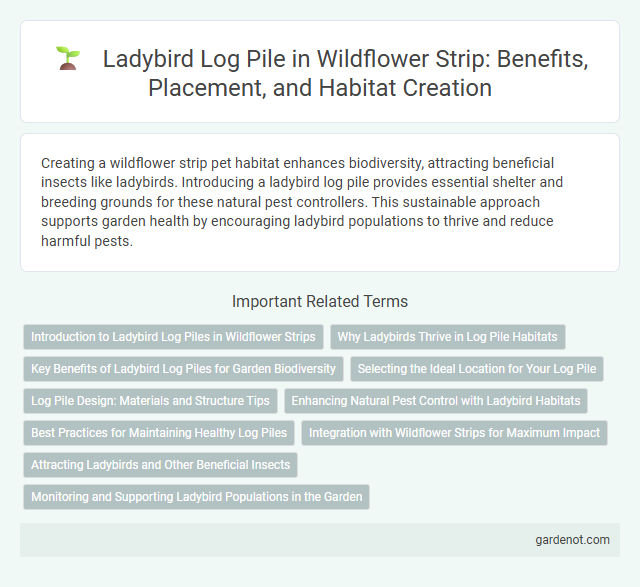Creating a wildflower strip pet habitat enhances biodiversity, attracting beneficial insects like ladybirds. Introducing a ladybird log pile provides essential shelter and breeding grounds for these natural pest controllers. This sustainable approach supports garden health by encouraging ladybird populations to thrive and reduce harmful pests.
Introduction to Ladybird Log Piles in Wildflower Strips
Ladybird log piles in wildflower strips provide essential habitats and breeding grounds for beneficial insects, supporting biodiversity and natural pest control. These log piles offer shelter and overwintering sites, creating microhabitats that enhance the ecological value of wildflower strips. Incorporating ladybird log piles boosts population densities of predatory beetles, contributing to healthier and more resilient agricultural ecosystems.
Why Ladybirds Thrive in Log Pile Habitats
Ladybirds thrive in log pile habitats due to abundant shelter and a rich supply of aphids and other small insects for food. The moist, decaying wood creates ideal microclimates that support diverse invertebrate populations benefiting ladybird survival. Log piles in wildflower strips increase biodiversity by providing critical breeding and overwintering sites for ladybird beetles.
Key Benefits of Ladybird Log Piles for Garden Biodiversity
Ladybird log piles create essential habitats for beneficial insects, enhancing natural pest control by attracting ladybirds, which prey on aphids and other garden pests. These log piles support biodiversity by providing shelter and breeding sites for a variety of invertebrates, promoting ecosystem balance. Incorporating ladybird log piles within wildflower strips boosts pollination and soil health, fostering a resilient and thriving garden environment.
Selecting the Ideal Location for Your Log Pile
Selecting the ideal location for a ladybird log pile involves choosing a sunny, sheltered spot within the wildflower strip to encourage ladybird activity and shelter. Position the log pile near native plants that attract aphids, providing a natural food source for ladybirds. Ensuring good drainage and protection from strong winds enhances the habitat quality, promoting healthy ladybird populations.
Log Pile Design: Materials and Structure Tips
Constructing a ladybird log pile involves using untreated hardwood logs, such as oak or ash, arranged in a loose, layered structure to provide ample crevices for shelter. Incorporating a mix of sizes, from thick logs to smaller twigs, enhances habitat diversity, supporting various ladybird species. Positioning the pile in a sunny, sheltered spot within the wildflower strip optimizes warmth and protection, boosting ladybird habitation and pest control benefits.
Enhancing Natural Pest Control with Ladybird Habitats
Creating a ladybird log pile within a wildflower strip enhances natural pest control by providing shelter and breeding sites for ladybirds, key predators of aphids and other harmful insects. The decaying wood in the log pile supports a diverse microhabitat that attracts ladybirds, encouraging their population growth and activity throughout the growing season. Integrating these habitats boosts ecological balance, reducing the need for chemical pesticides and promoting sustainable garden health.
Best Practices for Maintaining Healthy Log Piles
Maintaining a healthy ladybird log pile involves regularly checking moisture levels to prevent mold and decay while ensuring the wood remains damp enough to support insect habitats. Positioning logs in a sunny, sheltered spot encourages ladybird activity by providing warmth and protection from harsh weather. Avoid disturbing the pile frequently to preserve the natural environment crucial for ladybird survival and effective pest control in wildflower strips.
Integration with Wildflower Strips for Maximum Impact
Integrating a ladybird log pile within wildflower strips enhances biodiversity by providing essential habitats for beneficial insects like ladybirds, which naturally control aphid populations. The symbiotic relationship between the log pile's microhabitats and the diverse floral resources of wildflower strips promotes ecological balance and pest management. This strategic placement supports pollinator activity and pest predator nesting, maximizing the ecological impact of conservation efforts.
Attracting Ladybirds and Other Beneficial Insects
A ladybird log pile provides an ideal habitat for ladybirds and other beneficial insects by offering shelter, breeding grounds, and hunting sites for aphids and pests. Incorporating varied wood types and bark textures enhances biodiversity and encourages predatory insects to thrive in wildflower strips. These log piles support natural pest control, improving plant health and promoting ecological balance in the garden ecosystem.
Monitoring and Supporting Ladybird Populations in the Garden
A Ladybird log pile provides essential shelter and breeding sites, boosting local ladybird populations naturally. Monitoring involves regular checks for larvae and adults, ensuring habitat conditions remain optimal with adequate moisture and minimal disturbance. Supporting ladybirds also includes planting diverse wildflowers to supply ample aphid prey throughout the growing season.
Ladybird log pile Infographic

 gardenot.com
gardenot.com